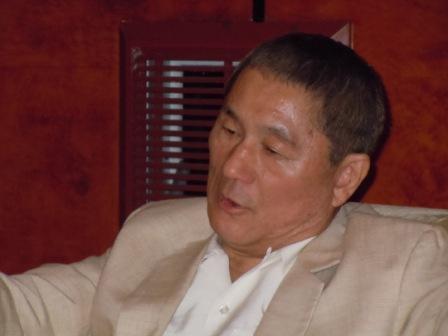Is one still allowed to critique movie violence? Recently, New York Times critic A. O. Scott, risking an image as fuddy-duddy, termed the hyper-brutal fun film Kick-Ass "unimaginative sadism", denouncing it as "evasive and irresponsible." Dumbfounded by the film's popularity, he expanded on his critique to say that it shows that today movie violence is--uncritically--mainstream.
My own students at NYU loved Kick-Ass, a few taking particular pleasure in being able to "identify" with a "powerful girl" who solved problems--through a machine gun.
The question of pleasure in movie violence is key to how one takes Takesha Kitano's newest film Outrage, which premiered this week at Cannes. The story of Yakuza mobsters, it made one fellow critic marvel how after all these years, the Japanese director can still come up with new creative ways to "kill people." The best--which Kitano himself admitted a certain pride in orchestrating--is a man with food smeared on his face, whose head is put in a noose, roped to a steering wheel and hung as the car accelerates. In the background, a serene blue sea and pretty white windmills.
"I really pursue the visual effects in that scene," smiled Kitano.
Indeed the film is extremely aesthetic and after becoming bored with figuring out who the gangsters were, I watched each scene as a marvel of an installation piece: swank offices, neon-lit roads, wide empty beaches, fastfood restaurants and casino rooms, each space lit eerily in steel blue. The film becomes a Greenaway exposition in how many ways one can torture and kill someone. A serpent in the bathtub, three chopsticks stuck in someone's cheeks, tattooed men in a sauna machine-gunned, their blood splattering over the inky green coils on their chests, a mouth drilled to bits.
Kitano is master of the image.
But not of meaning, drama, character or plot. Violence aside, the film is dull. Nothing moves beyond the sequence of violent images. A few moments of humor make the nihilism complete: three men have a shoot-out and all die at the same moment, one man's feet flopping silly as he falls.
"Do you have a death wish?" I asked Kitano---which the translator nicely translated for me as Freud's thanatos.
"No," said Kitano, a bit low-energy, arms folded in his smart beige suit. "It's not that deep or complicated or psychological as that. I just wanted to portray men foolishly killing each other. The film has a circular structure. One little thing causes something else, and everyone continues to kill each other, and different faces will do the same thing all over again. Bad guys destroy each other mutually."
He continued, explaining the violence as a form of analysis: "I feel like a biologist, looking at ants killing the worms. The camera is watching the cruel life of the natural world. I like the detachment. Although it portrays the violence of the Yazuka, if you take out the guns and knives, you see a parallel of what is happening in today's Japanese corporate culture."
As for why he chose to make a Yazuka film now, after foregoing the genre for the last decade, he quipped that he didn't have success commercially with his previous film.
He then added more seriously that while preparing for the shoot, he had experienced an identity crisis.
"I was in the middle of a transformation period from a middle-aged man to an old man, so these were excruciating years. Now that I am comfortable with being an old man, Outrage is the result."
I asked Kitano pointblank if he thought his aesthetic violence might be bad for spectators.
Kitano's response was more nihilistic than his film:
"Well I have never been concerned about the effect of violence on the audience. It feels more apocalyptic to see the news, like Iraq and Afghanistan . When you look at the real world, Iran is selling uranium to Turkey, volcanos erupt and planes can't fly, and we have oil spoiling the gulf of Mexico. Reality is much scarier than Outrage. The goriness on the screen is less than that of the real world. I am often asked about violence in cinema, but I worry about those other films: the tear-jerking humanistic sentimental stories. Do these ever affect the world on global level? Do they make the world an eco-friendly humanistic world?"

